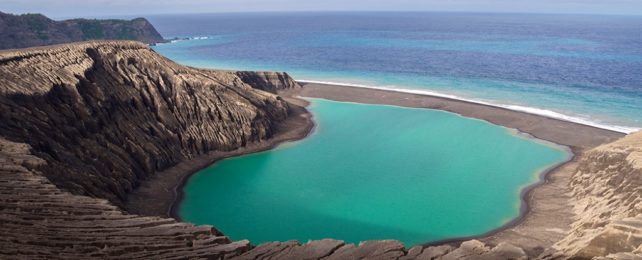When a new island arose from the South Pacific in 2015, it created an unprecedented opportunity not just for geologists and volcanologists, but for biologists and ecologists, too.
The appearance of a new island offers a chance to learn about how ecosystems begin, starting with microbial pioneers that colonize new land like this, before plants or animals show up.
Hunga Tonga-Hunga Ha'apai island (Hunga Tonga) didn't stick around for very long – after it was formed by a volcanic eruption in 2015, it was destroyed by another eruption in early 2022.
During the seven years it existed, however, the island revealed some interesting secrets.
In a new study, researchers report evidence of an unexpected community of microbes on the island that metabolize sulfur and atmospheric gases, similar to organisms that occupy very different habitats: hot springs or deep-sea hydrothermal vents.
"We didn't see what we were expecting," says microbial ecologist Nick Dragone from the University of Colorado.
"We thought we'd see organisms you find when a glacier retreats, or cyanobacteria, more typical early colonizer species – but instead we found a unique group of bacteria that metabolize sulfur and atmospheric gases."
Dragone and fellow researchers collected 32 soil samples from the island, on surfaces ranging from sea level up to the crater summit, about 120 meters (394 ft) high. They then extracted and sequenced DNA from the samples.
Plants colonized the island fairly quickly after it formed, probably thanks to seeds in bird droppings, but the researchers focused their collection efforts on unvegetated surfaces.
They found bacteria and archaea in all their samples from the volcano's cone, although those microbes were less diverse than microbes from nearby vegetated areas – and very different.
It would make sense if the first microbes on a new island came from either ocean water or bird droppings, but that doesn't seem to be where these odd bacteria and archaea originated. Rather, the researchers suspect these microbes might have come from deep underground.
"One of the reasons why we think we see these unique microbes is because of the properties associated with volcanic eruptions: lots of sulfur and hydrogen sulfide gas, which are likely fueling the unique taxa we found," Dragone says.
"The microbes were most similar to those found in hydrothermal vents, hot springs like Yellowstone, and other volcanic systems. Our best guess is the microbes came from those types of sources."
Having the chance to investigate this kind of system is rare. Big eruptions are one thing; watching a blank-slate ecosystem develop on a newly formed volcanic island is another.
In the past 150 years, Hunga Tonga is only the third landmass like this to appear and last for more than a year, the researchers say, and the first in the tropics.
While scientists also flocked to study the arrival of life on previous newly formed islands, they focused more on plants and animals than microbes.
"These types of volcanic eruptions happen all over the world, but they don't usually produce islands," Dragone says. "We had an incredibly unique opportunity. No one had ever comprehensively studied the microorganisms on this type of island system at such an early stage before."
And no one will have a chance to study the island's inhabitants again, at least not directly. Seven years after it emerged from the Pacific, Hunga Tonga vanished in spectacular fashion.
When the volcano erupted again in January 2022, it produced the largest explosive eruption of the 21st century, with the highest plume of steam and ash in recorded history. Hunga Tonga was obliterated – but not before scientists managed to learn intriguing details about its short life.
"We are of course disappointed that the island is gone, but now we have a lot of predictions about what happens when islands form," Dragone says.
"So if something formed again, we would love to go there and collect more data. We would have a game plan of how to study it."
The study was published in mBio.
